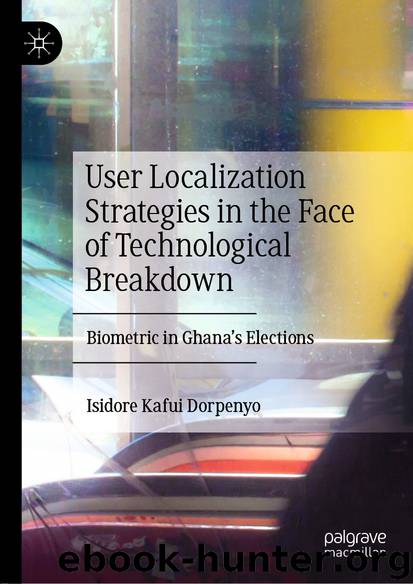User Localization Strategies in the Face of Technological Breakdown by Isidore Kafui Dorpenyo

Author:Isidore Kafui Dorpenyo
Language: eng
Format: epub
ISBN: 9783030263997
Publisher: Springer International Publishing
Creating Biometric Ethos Through Chieftaincy
In the online video, the character, Kofi Ghana, exemplifies how a local authority is used to help persuade the Ghanaian voter about the efficiency of the biometric. Kofi is an Akan name for a Ghanaian male born on Friday, and his surname (last name), Ghana, gives an indication that he comes from Ghana. In most Ghanaian customary rites, it is believed that a child comes to the world with a birth name, which is literally the day you were born. The Akans of Ghana refer to this birth name as Kra din. “Kra” is the “soul” and “din” is translated as “name.” Meaning that “kra din” is the “soul name” that every individual bear. You come into the world with the “kra din” before you are given any other name. I was born on a Wednesday, so my kra din is Kwaku. I use this as an example to indicate that “Kra din” is part of a Ghanaian identity. For me, the use of a character who bears a Ghanaian name and attribute is a way of localizing the biometric.
More so, he wears kente, a rich royal cloth worn only on special occasions by chiefs, a native sandal, and a crown. These are symbols of authority and kingship in a cross section of the Ghanaian society, especially those in the southern part of Ghana (I add that these days, kente is not a preserve for chiefs only; anyone who has the means can afford and use it). This adds that kente represents wealth and tradition. Through Kofi Ghana, we witness an attempt to accommodate technology through an elevation of one of the varied customs of Ghana, chieftaincy. A chief, as Utley (2009) posits, is an “amalgam of political head, religious head, judge, war leader, and advisor” (p. 64). Even though the chief’s power has been lessened as a result of the practice of Western forms of democracy, he is still respected in the Ghanaian society. Thus, to use someone who epitomizes chieftaincy is in a way to first try to localize the technology and second communicate the credibility of the biometric technology. Here, Kofi Ghana, the epitome of the seat of traditional wisdom and power, adds what Aristotle calls “ethos” to the biometric. In Rhetoric, Aristotle outlined the modes of persuasion. The first mode of persuasion depends on the speaker’s character; the second focuses on putting the audience into a certain frame of mind; the third provided by the words or logos of speaker (McKeon, 2009, p. 1329). In the first mode “persuasion is achieved by speaker’s personal character when the speech is spoken as to make us think him credible” (McKeon, 2009, p. 1329). Aristotle believes that we believe good men readily; thus, speakers must be able to create impressions with what they say and not what people think of their character. Thus it was not mere happenstance that STL chooses a seat of authority as the accommodator of the technology to the electorate. When
Download
This site does not store any files on its server. We only index and link to content provided by other sites. Please contact the content providers to delete copyright contents if any and email us, we'll remove relevant links or contents immediately.
| Coding Theory | Localization |
| Logic | Object-Oriented Design |
| Performance Optimization | Quality Control |
| Reengineering | Robohelp |
| Software Development | Software Reuse |
| Structured Design | Testing |
| Tools | UML |
Deep Learning with Python by François Chollet(12570)
Hello! Python by Anthony Briggs(9914)
OCA Java SE 8 Programmer I Certification Guide by Mala Gupta(9796)
The Mikado Method by Ola Ellnestam Daniel Brolund(9778)
Dependency Injection in .NET by Mark Seemann(9337)
Algorithms of the Intelligent Web by Haralambos Marmanis;Dmitry Babenko(8296)
Test-Driven iOS Development with Swift 4 by Dominik Hauser(7763)
Grails in Action by Glen Smith Peter Ledbrook(7696)
The Well-Grounded Java Developer by Benjamin J. Evans Martijn Verburg(7557)
Becoming a Dynamics 365 Finance and Supply Chain Solution Architect by Brent Dawson(7071)
Microservices with Go by Alexander Shuiskov(6834)
Practical Design Patterns for Java Developers by Miroslav Wengner(6755)
Test Automation Engineering Handbook by Manikandan Sambamurthy(6696)
Secrets of the JavaScript Ninja by John Resig Bear Bibeault(6413)
Angular Projects - Third Edition by Aristeidis Bampakos(6099)
The Art of Crafting User Stories by The Art of Crafting User Stories(5628)
NetSuite for Consultants - Second Edition by Peter Ries(5562)
Demystifying Cryptography with OpenSSL 3.0 by Alexei Khlebnikov(5368)
Kotlin in Action by Dmitry Jemerov(5062)
